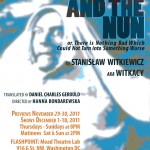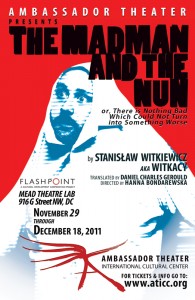Madness: For Witkiewicz, the play’s the thing

WASHINGTON, DC, December 4, 2011 — The artist is mad, insane, suicidal. In The Madman and the    Nun, a play set entirely in a lunatic asylum, we meet poet Alexander Walpurg, who’s diagnosed with “acute  dementia praecox†and bound by a straitjacket.
Theater goers, confined with him for 65 fast-moving minutes, are in for a hilarious romp as they are drawn into Walpurg’s profound commentary on creativity and madness.
Polish absurdist playwright Stanislaw Ignacy Witkiewicz (aka Witkacy), who himself committed suicide in 1939 at age 54, wrote this surreal, engaging, erotic and biting satire of psychoanalysis and the perils of the artist in 1923.
Director Hanna Bondarewska has created a spirited update of the play. The  patient’s file is handed to the viewer on entering, and it conveniently  functions as the drama’s program notes. Two live computer  screens illuminate the action on stage, transmitting real time images of the  poet Walpurg. A brand new app for the iPad is unveiled when the trendy device becomes a weapon that’s used to beat our anti-hero.
Bondarewska brings this play to a close, gloriously, lightly, and ingeniously by deploying the song “Chapel of loveâ€Â and blending it into Witkacy’s surreally happy ending. This and other theatrical touches have earned for Bondarewska the attention of the current batch of literary scholars who are now giving Witkacy his belated due.
After she performed a staged reading of Witkacy’s Country House, she says, “I got phone calls from Professors Daniel Gerould and Mark Rudnicki,†experts on the playwright’s work which also includes an extensive portfolio of paintings. As a result of these conversations, “They asked me to perform at their conference last year.†That formed the seed of this new production that inspired Gerould to journey to DC to see. Clearly, Bondarewska has earned his attention, and she deserves ours as well.
In The Madman and the Nun, Bondarewska has brought to the fore the dangers facing the creative soul, which she describes as “misunderstanding and vulnerability.â€
In Madman, Walpurg expresses the pain of creation to Sister Anna, who releases him from the straitjacket, gives him a pencil, and quickly becomes his lover:
“I’m composing poetry again now. But I think my poems are getting worse. I can’t write anymore. But then you can also use a pencil to kill yourself.â€
The artist’s suffering for lack of appreciation permeates the play. It seems to parallel the trajectory of the playwright’s own life. Witkacy’s contemporaries and friends – painters, composers, and, most well-known to Americans, pianist Artur Rubenstein – eclipsed him.
One of the Madman’s many looks.
For the playwright, competition constitutes only part of the artist’s  dilemma and the play’s territory. The poet’s vulnerability to all he sees, his  own unconscious mind, his openness to the pain of others, his ability to see  what the other has been through—all these feed his art yet drive him  toward madness.
Witkacy has a lot of company. Here is an abbreviated list of just some of the  artists who have died by their own hand:
- The poet Paul Celan
- The painter Vincent Van Gogh
- The poet Sylvia Plath
- The novelist Virginia Woolf
- The painter Mark Rothko
- The novelist Ernest Hemingway
- Most recently, the novelist David Foster Wallace
Vincent Van Gogh said of his own recurring breakdowns,
“And perhaps the disease of the heart is caused by this. One does not rebel against things, it does no good; nor is one resigned to them; one’s ill because of them and one does not get better.â€
Must it be this way?
William Styron, author of Sophie’s Choice, describes in Darkness Visible: A Memoir of Madnesshis dependence on alcohol and his journey through depression.
Like the poet Baudelaire, he despaired, I have felt the wind of the wing of madness.
He adds:
“As for that initial triggering mechanism—what I have called the manifest crisis—can I really be satisfied with the idea that abrupt withdrawal from alcohol started the plunge downward? … Or could it be that a vague dissatisfaction with the way in which my work was going—the onset of inertia which has possessed me time and time again during my writing life, has made me crabbed and discontented—had also haunted me more fiercely …?â€
He, like Witkacy’s poet, finds a way through the morass, depending on how the viewer chooses to read the ending of the play. That duplicity, the either/or, the to-be-or-not-to-be, is the territory of the play.
Bondarewska, artistic director of DC’s Ambassador Theater troupe, fully understands the artist’s plight. In presenting Madman here, she wants to make a difference. The play for her is the thing but not the only thing. She teaches through her program Ambassadors of International Culture and is now working with children at Hoffman-Boston Elementary school in Arlington, Virginia.
Her aim is to to build confidence, communication and hope. She wants to insulate the young mind against the vulnerability the creative soul faces. But in addition, she lives for the artist in us all. “In today’s world of technology,†she says, “the artist’s time is ever more narrowed to be free, to be devoted to their art.†Her greatest fear is that the contemporary artist, like Witkacy, will choose suicide rather than go on living and creating art.
The Madman and the Nun is a witty, lively, but extraordinarily thoughtful play. Theatergoers, artists, creative souls and anyone who wants both a fast romp and an intellectual challenge should carve some time out of their busy schedules to take in this most unusual play.
The Madman and the Nun runs through Dec. 18, 2011, 8 pm at Mead Theater Lab at Flashpoint, 916 G Street, NW, Washington, DC. Tickets: $30. Students and senior citizens $20. Buy tickets online http://www.aticc.org/home/box-office or at the door.
The question remains, “Is the artist doomed?†For a positive take, listen to Elizabeth Gilbert who gave the following TED talk on precisely that question. This clip is on the long side, so sample as much as you wish.
Mary L. Tabor is the author of the memoir: (Re)Making Love: a sex after sixty story and The Woman Who Never Cooked. She says, “I ferret out the detail, love the footnote, am never bored and believe it all leads to story. Best advice I ever got? ‘Only connect …’ E.M. Forster†Find out more at http://maryltabor.com






